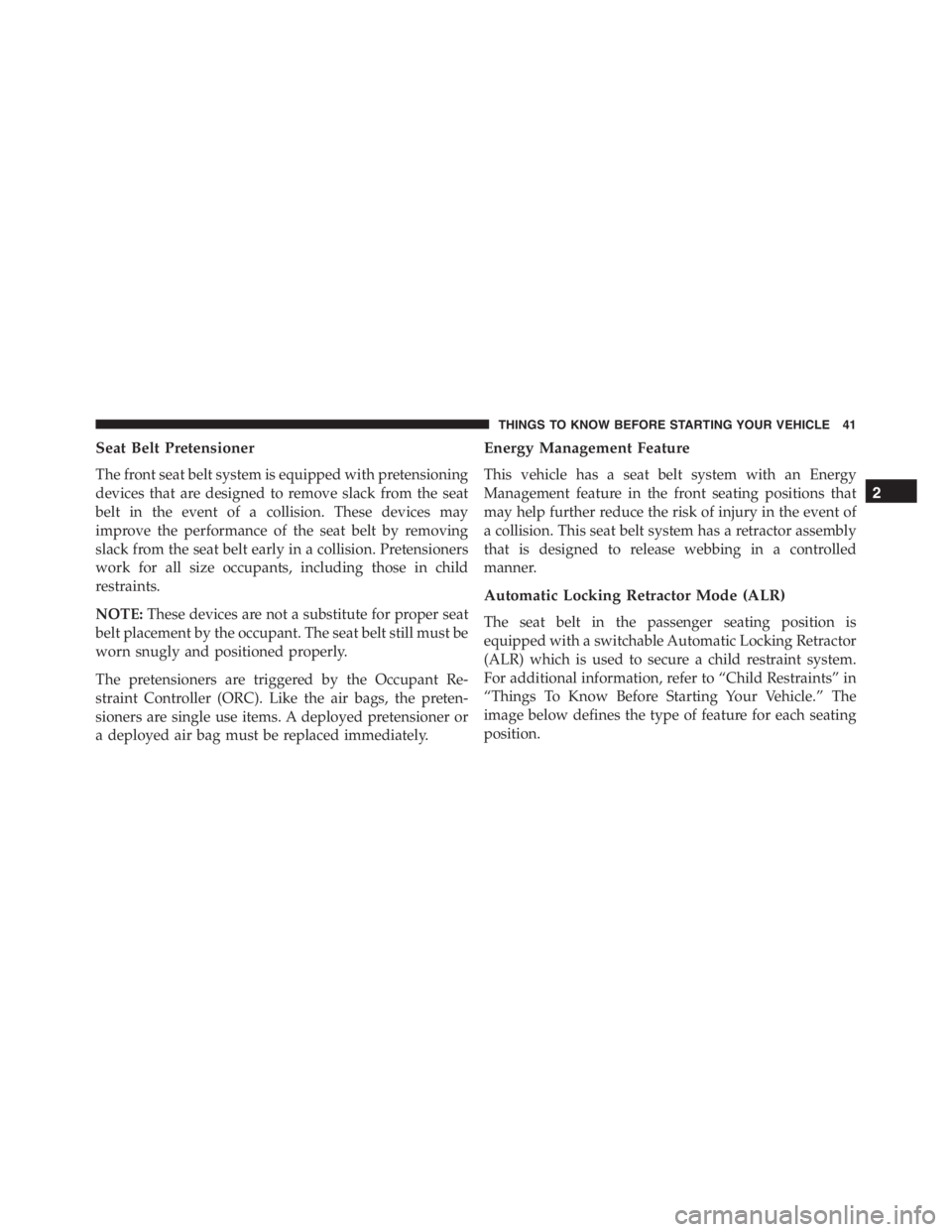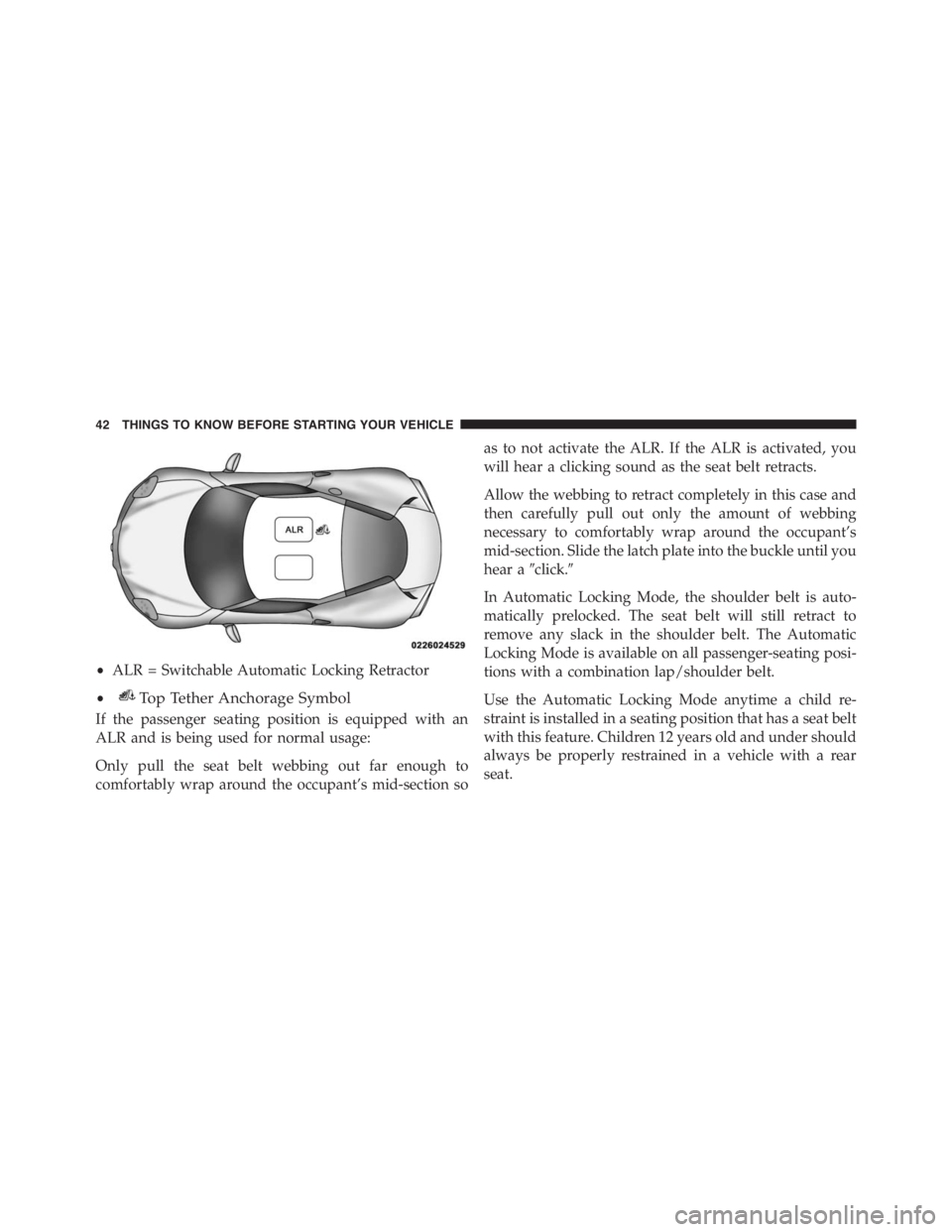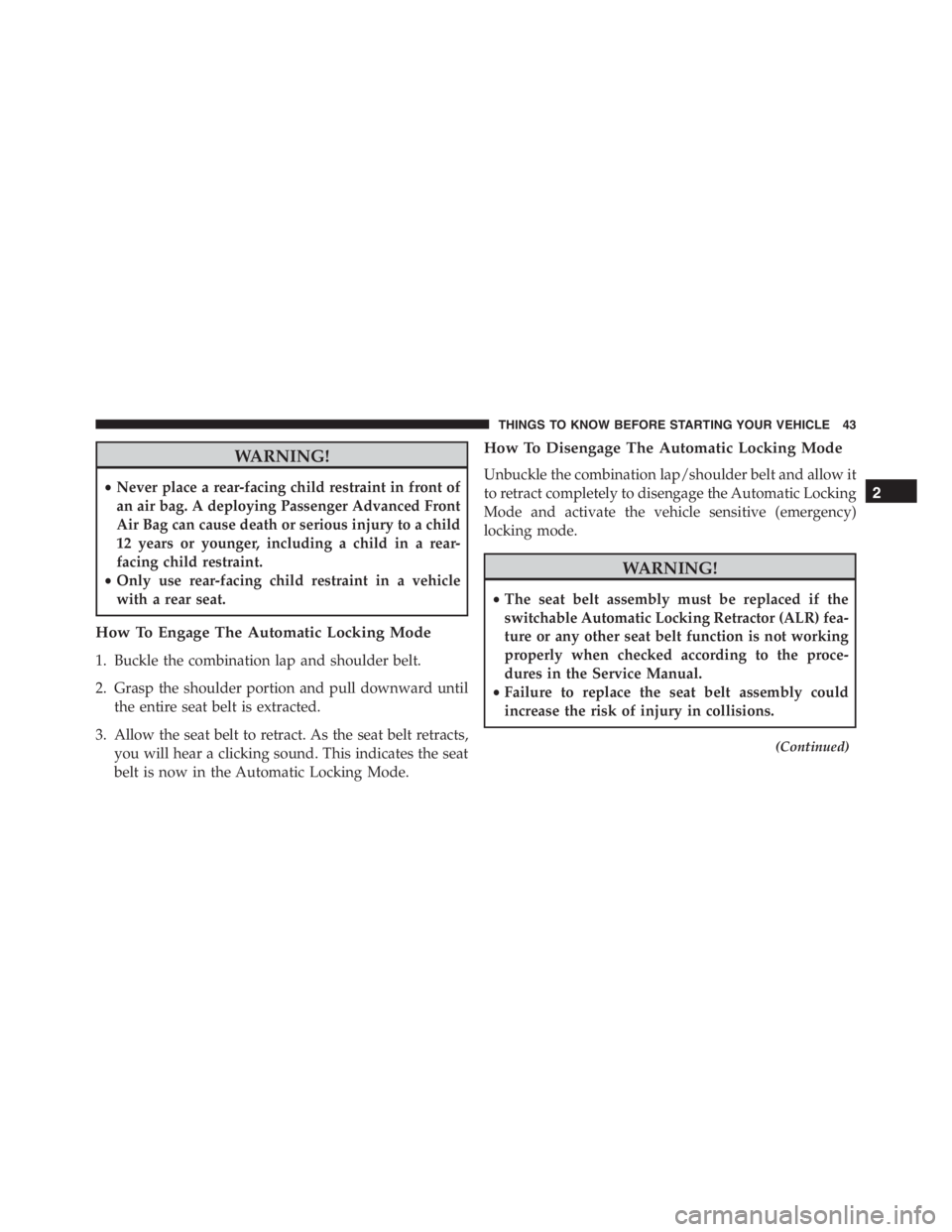Page 28 of 348
To restore the starting condition of the door locks (only if
battery charge restored), proceed as follows:
•Push the Unlock button on the remote control;
•Push the door locking/unlocking LED indicator but-
ton
on the dashboard; or
•Introduce the metal insert of the ignition key in the
front door pawl; or
•Pull the internal door handle.
Door Opening/Closing Mechanism Reset
If the battery is disconnected or the protection fuse
blows, the door opening/closing mechanism must be
reset as follows:
1. Close all the doors.
2. Push the unlock button on the key or the door
locking/unlocking LED indicator button
on the
dashboard.
3. Push the lock button on the key or the door locking/
unlocking LED indicator button
on the dash-
board.
Emergency Door Lock Function
26 THINGS TO KNOW BEFORE STARTING YOUR VEHICLE
Page 32 of 348

Raise the decklid and release supporting rod from its
locking device.Insert the end of the rod in housing, making sure that the
rod engages in the smallest hole of the retaining clip.
Care must be taken to keep the decklid raised until the
rod is fixed in the correct position.
NOTE:Maintain a tight grip on the decklid when raising,
in order to prevent any external occurrence (e.g. a gust of
wind) from suddenly opening the decklid to end of
travel. Additionally, in order to prevent any damage to
the car or broken windows, do not force the decklid
beyond the opening position necessary to secure the
supporting rod in the hole of the retaining clip.
Closing Procedure
1. Hold the decklid up with one hand and use the other
to remove rod from housing and reinsert it in its
locking device.
2. Lower the decklid approximately 7.8 inches (20 cm)
from the engine compartment and let it drop. Make
Decklid Release Lever Location
1 — Decklid Release Lever 30 THINGS TO KNOW BEFORE STARTING YOUR VEHICLE
Page 33 of 348

sure that the decklid is completely closed and not only
fastened in safety position by trying to open it. If it is
not completely closed, do not push the decklid down,
but raise it and repeat the procedure.
NOTE:Always check that the decklid is closed correctly
to prevent it from opening while the car is travelling.
WARNING!
•The maximum permitted load in the luggage com-
partment, in addition to the kits provided, is
33.1 lbs. (15 kg). Do not exceed the maximum
permitted load in the luggage compartment.
•When accessing the rear luggage compartment, do
not come into contact with engine, or other compo-
nents, that may be hot and could burn you if
touched.
(Continued)
WARNING!(Continued)
•Access the luggage compartment only with the
vehicle stationary. Before exiting a vehicle, you
should always shift the vehicle into gear, remove
the key fob from the ignition, and apply the
parking brake to secure the vehicle against un-
wanted movement.
•The decklid may drop suddenly, causing serious
injury, if the supporting rod is not positioned
correctly.
•The decklid must always be closed properly, and
the lock engaged, while the car is in motion.2
THINGS TO KNOW BEFORE STARTING YOUR VEHICLE 31
Page 37 of 348

NOTE:If BeltAlert has been deactivated, the Seat Belt
Reminder Light
will continue to illuminate while the
driver ’s seat belt remains unbuckled and a continuous
chime will sound when the ignition switch is first
placed in the START or ON/RUN position.
Lap/Shoulder Belts
All seating positions in your vehicle are equipped with
lap/shoulder belts.
The seat belt webbing retractor will lock only during very
sudden stops or collisions. This feature allows the shoul-
der part of the seat belt to move freely with you under
normal conditions. However, in a collision the seat belt
will lock and reduce your risk of striking the inside of the
vehicle or being thrown out of the vehicle.
This seat belt system has a retractor assembly that is
designed to release webbing in a controlled manner. Thisfeature is designed to help reduce the seat belt force
acting on the occupant’s chest.
WARNING!
•Relying on the air bags alone could lead to more
severe injuries in a collision. The air bags work
with your seat belt to restrain you properly. In
some collisions, the air bags won’t deploy at all.
Always wear your seat belt even though you have
air bags.
•In a collision, you and your passengers can suffer
much greater injuries if you are not properly buck-
led up. You can strike the interior of your vehicle or
other passengers, or you can be thrown out of the
vehicle. Always be sure you and others in your
vehicle are buckled up properly.
(Continued)
2
THINGS TO KNOW BEFORE STARTING YOUR VEHICLE 35
Page 43 of 348

Seat Belt Pretensioner
The front seat belt system is equipped with pretensioning
devices that are designed to remove slack from the seat
belt in the event of a collision. These devices may
improve the performance of the seat belt by removing
slack from the seat belt early in a collision. Pretensioners
work for all size occupants, including those in child
restraints.
NOTE:These devices are not a substitute for proper seat
belt placement by the occupant. The seat belt still must be
worn snugly and positioned properly.
The pretensioners are triggered by the Occupant Re-
straint Controller (ORC). Like the air bags, the preten-
sioners are single use items. A deployed pretensioner or
a deployed air bag must be replaced immediately.
Energy Management Feature
This vehicle has a seat belt system with an Energy
Management feature in the front seating positions that
may help further reduce the risk of injury in the event of
a collision. This seat belt system has a retractor assembly
that is designed to release webbing in a controlled
manner.
Automatic Locking Retractor Mode (ALR)
The seat belt in the passenger seating position is
equipped with a switchable Automatic Locking Retractor
(ALR) which is used to secure a child restraint system.
For additional information, refer to “Child Restraints” in
“Things To Know Before Starting Your Vehicle.” The
image below defines the type of feature for each seating
position.
2
THINGS TO KNOW BEFORE STARTING YOUR VEHICLE 41
Page 44 of 348

If the passenger seating position is equipped with an
ALR and is being used for normal usage:
Only pull the seat belt webbing out far enough to
comfortably wrap around the occupant’s mid-section soas to not activate the ALR. If the ALR is activated, you
will hear a clicking sound as the seat belt retracts.
Allow the webbing to retract completely in this case and
then carefully pull out only the amount of webbing
necessary to comfortably wrap around the occupant’s
mid-section. Slide the latch plate into the buckle until you
hear a�click.�
In Automatic Locking Mode, the shoulder belt is auto-
matically prelocked. The seat belt will still retract to
remove any slack in the shoulder belt. The Automatic
Locking Mode is available on all passenger-seating posi-
tions with a combination lap/shoulder belt.
Use the Automatic Locking Mode anytime a child re-
straint is installed in a seating position that has a seat belt
with this feature. Children 12 years old and under should
always be properly restrained in a vehicle with a rear
seat.
•ALR = Switchable Automatic Locking Retractor
•
Top Tether Anchorage Symbol
42 THINGS TO KNOW BEFORE STARTING YOUR VEHICLE
Page 45 of 348

WARNING!
•Never place a rear-facing child restraint in front of
an air bag. A deploying Passenger Advanced Front
Air Bag can cause death or serious injury to a child
12 years or younger, including a child in a rear-
facing child restraint.
•Only use rear-facing child restraint in a vehicle
with a rear seat.
How To Engage The Automatic Locking Mode
1. Buckle the combination lap and shoulder belt.
2. Grasp the shoulder portion and pull downward until
the entire seat belt is extracted.
3. Allow the seat belt to retract. As the seat belt retracts,
you will hear a clicking sound. This indicates the seat
belt is now in the Automatic Locking Mode.
How To Disengage The Automatic Locking Mode
Unbuckle the combination lap/shoulder belt and allow it
to retract completely to disengage the Automatic Locking
Mode and activate the vehicle sensitive (emergency)
locking mode.
WARNING!
•The seat belt assembly must be replaced if the
switchable Automatic Locking Retractor (ALR) fea-
ture or any other seat belt function is not working
properly when checked according to the proce-
dures in the Service Manual.
•Failure to replace the seat belt assembly could
increase the risk of injury in collisions.
(Continued)
2
THINGS TO KNOW BEFORE STARTING YOUR VEHICLE 43
Page 46 of 348

WARNING!(Continued)
•Do not use the Automatic Locking Mode to restrain
occupants who are wearing the seat belt or children
who are using booster seats. The locked mode is
only used to install rear-facing or forward-facing
child restraints that have a harness for restraining
the child.
Supplemental Restraint System (SRS)
Air Bag System Components
Your vehicle may be equipped with the following air bag
system components:
•Occupant Restraint Controller (ORC)
•Air Bag Warning Light
•Steering Wheel and Column
•Instrument Panel•Knee Impact Bolsters
•Advanced Front Air Bags
•Supplemental Side Air Bags
•Supplemental Driver Knee Air Bag
•Front and Side Impact Sensors
•Front Seat Belt Pretensioners, Seat Belt Buckle Switch,
and Seat Track Position Sensors
Advanced Front Air Bags
This vehicle has Advanced Front Air Bags for both the
driver and front passenger as a supplement to the seat
belt restraint systems. The driver’s Advanced Front Air
Bag is mounted in the center of the steering wheel. The
passenger’s Advanced Front Air Bag is mounted in the
instrument panel. The words AIRBAG are embossed on
the air bag covers.
44 THINGS TO KNOW BEFORE STARTING YOUR VEHICLE